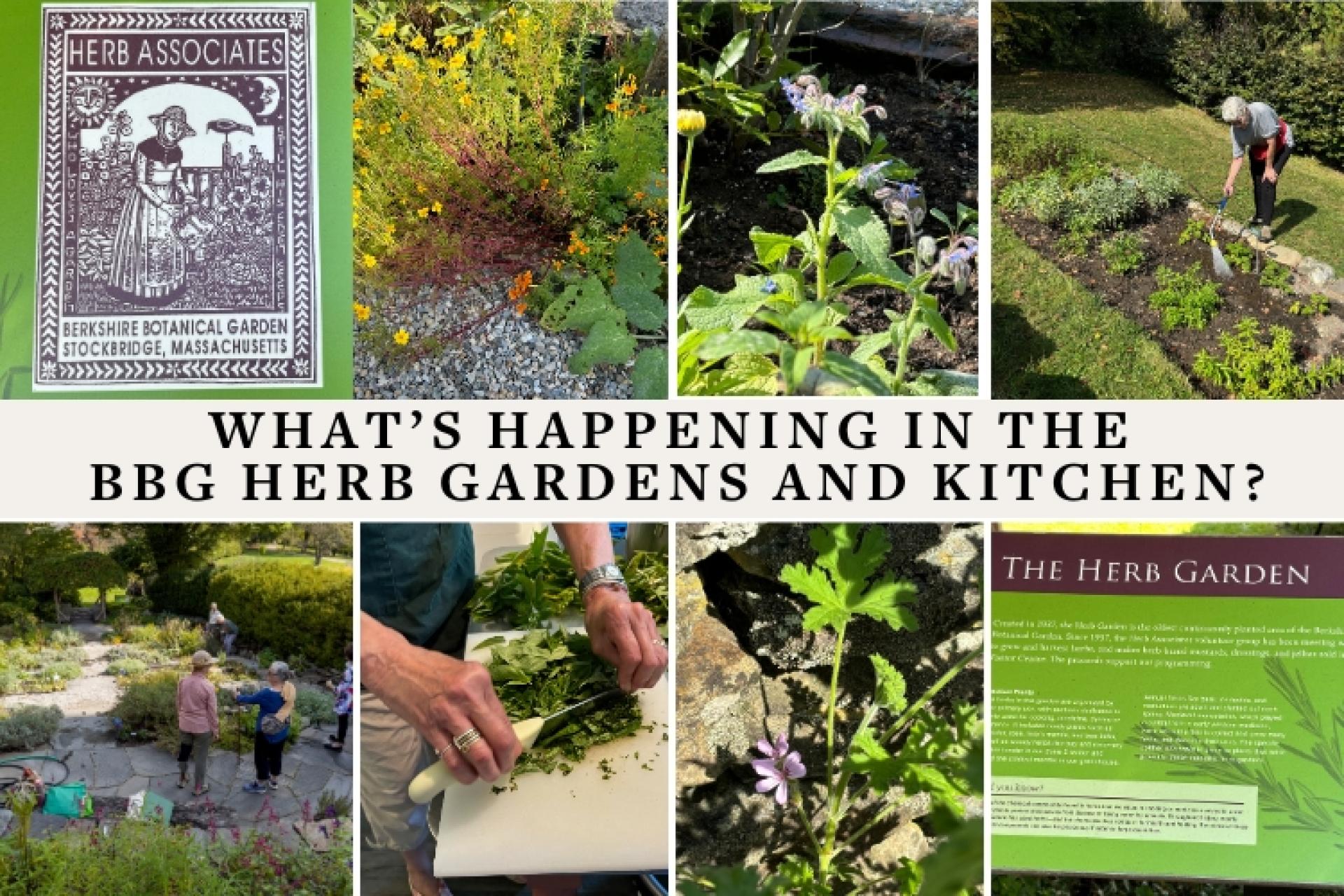You are here
What Is Happening in the BBG Herb Gardens and Kitchen This Week (Sept. 17)?
What Is Happening in the BBG Herb Gardens and Kitchen This Week (Sept. 17)?
By Barbara F. Smith
Several of the Garden Crew were busy today watering both the Herb Display and the Production Gardens — we need the rain!! Thanks to the vagaries of later-than-usual planting, in the Herb Display Gardens (near the Center House) are two herbs currently blooming side by side (a few weeks later than otherwise expected) — Calendula and Borage (pictured above).
Borage (Borago officinalis) can grow to three feet tall, with beautiful, star-shaped bright blue flowers above hollow stems with coarse hairs; the entire plant having a cucumber scent. The plant prefers full sun and well composted soil to thrive. It can serve as a good garden companion plant, by deterring tomato hornworms and Japanese beetles or by stimulating the growth of strawberries.
Borage seed oil is a rich source of gamma-linolenic acid (GLA), which acts as an anti-inflammatory, helping in the treatment of dry or itching skin conditions. In the kitchen, borage flowers are used fresh in salads or as a garnish for cold soups, and if crystallized, as decorations for cakes or other baked goods. The old herbal saying “borage brings courage” gives a hint to its uses long ago.
Growing next to the borage plant is Calendula, also known as Pot Marigold (Calendula officinalis). This plant has daisy-like golden yellow or orange flowers, originally in a single form, now also bred to have double flower forms. This plant should not be confused with another popular garden flower named marigold (in the Tagetes genus, including the so-called African and French marigolds). In colonial America, early settlers used calendula to add color and flavor to soups, potted cheese and meats – as a sort of “poor man’s saffron.”
Calendula flower petals possess anti-inflammatory, anti-microbial and anti-fungal properties, and they may be prepared for use in an ointment, cream or infused oil. People in the Elizabethan era were fond of the simple flower for its habit of closing its petals at night, then reopening them at dawn. William Shakespeare, who appreciated calendula’s “innocent sunny charms” wrote in 1594:
With pearly sweat resembling dew of night,
Her eyes like marigolds, had sheathed their light
And canopied in darkness sweetly lay
Til they might open to adorn the day.
... Another late-blooming herb was leaning against the stone wall skirting its flower bed — a scented geranium (Pelargonium sp. geraniaceae), pictured above. The category “scented geranium” contains up to 300 species, with wide ranging fragrances, to name a few, apple, ginger, nutmeg, lemon, carrot and gooseberry! These soft to semi-hard wooded shrubs or subshrubs have various leaf shapes. Historically, their most important use was in preparing fragrances, with their oils added to perfumes and toiletries. In addition, scented geraniums have antifungal, antibacterial and antiseptic qualities, used to treat digestive complaints or more recently for bronchitis or sore throats, or in tick repellant for dogs, or in repellants against mosquitos or lice. In the kitchen, fresh scented geranium leaves may be infused in cream or milk, to be an ingredient in ice cream or custards. Dried leaves may be added to teas. Fresh scented geranium flowers may be added to salads or steeped to make herb vinegar or simple syrup.
Two Herb Associates recently attended a regional meeting of the Herb Society of America, where scented geraniums were a discussion topic. They returned with the inspiration shared with the Kitchen Crew to prepare a Rose Geranium Simple Syrup and a Rose Geranium Jelly. The syrup would be a delightful addition to a fresh fruit salad, in mock- or cocktails, or to sweeten tea.
In a similar vein, the Kitchen Crew prepared Peach Basil Shrub, a new flavor added to the popular shrub product line, which could also be used as the syrup was, or possibly as the base for a salad dressing, once a neutral olive oil was added.
Another batch of BBG Barbecue Sauce was prepared, along with another batch of Harvest Marmalade, featuring beautiful yellow tomatoes, lemon, and cinnamon as flavor notes.
It’s true, the growing season is winding down, but the work of the Herb Associates continues at least for the next few weeks. We’ll continue to harvest the bounty of our gardens and make delicious products for your enjoyment. Check our full supply at the Visitors Center Gift Shop, or some to visit us at the Harvest Festival in October!
The Berkshire Botanical Garden’s Herb Associates began in 1957 and have been making and selling products for the benefit of BBG ever since. At BBG, the Herb Associates oversee a display garden and production garden, both located near the Center House. Members/volunteers meet every Tuesday morning during the late spring through mid-autumn each year, coinciding when the gardens themselves are open to the public. Members plant, weed and tend the gardens, as well as harvest and process the variety of herbs.
Help Our Garden Grow!
Your donation helps us to educate and inspire visitors of all ages on the art and science of gardening and the preservation of our environment.
All Donations are 100 percent tax deductible.


